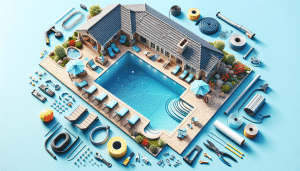Are you concerned about your little ones’ safety near your backyard pool? You’re not alone, and that’s why we’re here with effective, easy-to-follow solutions. This blog is designed for homeowners like you, eager to learn about DIY pool fence installations that prioritize child safety.
Contents
- 1 Understanding the Importance of Pool Safety
- 2 Choosing the Right Materials for Your Pool Fence
- 3 Tools You Will Need
- 4 Preparing the Area for Installation
- 5 Measuring and Marking Your Layout
- 6 Installing the Fence Posts
- 7 Attaching the Fence Panels
- 8 Installing a Self-Closing Gate
- 9 Performing a Safety Check
- 10 Maintenance Tips for Longevity
- 11 Final Thoughts
Understanding the Importance of Pool Safety
Before jumping into the installation process, we must understand why pool safety is critical. Drowning is a leading cause of accidental death among children, and having the right safety measures in place can prevent tragedies.
Pool fences act as the first line of defense, providing a barrier between curious toddlers and the water. With the right fence, we can breathe easy, knowing our families are protected even during moments when our attention is diverted.
Choosing the Right Materials for Your Pool Fence
One of the first steps in your DIY pool fence project is selecting the appropriate materials. We recommend materials like aluminum, vinyl, or mesh that offer durability and peace of mind.
Each material comes with its own set of benefits. For instance, aluminum is rust-resistant and requires minimal maintenance, while vinyl is aesthetically pleasing and weather-resistant. Mesh fences, on the other hand, are flexible and can be easily removed or adjusted when needed.
Tools You Will Need
Let’s make sure you’re fully equipped for the job. Having the right tools at hand is essential for a smooth installation process. Start with a measuring tape, level, and drill.
You’ll also need other basic tools such as a post-hole digger and screwdriver. These tools will help ensure the fence is installed securely and safely, providing effective protection for your loved ones.
Preparing the Area for Installation
Preparing your pool area is crucial for a successful installation. Firstly, clear the perimeter around the pool to remove any obstacles that might interfere with the process. This includes plants, furniture, and toys.
Next, ensure that the ground is as level as possible. This will not only make the installation easier but will also guarantee that your fence stands firm and straight, enhancing its effectiveness.
Measuring and Marking Your Layout
Accurate measurement and marking are significant for a successful fence installation. Start by measuring the total perimeter that needs to be fenced. This will determine the amount of fencing material you’ll need.
Once you’ve got your measurements, use marking paint or stakes to outline where the fence will be. This step will ensure that the installation process goes smoothly without any unexpected surprises.
Installing the Fence Posts
Fence posts are the backbone of your pool fence. Begin by digging holes where you’ve marked your layout. It’s crucial to make sure these holes are deep enough to provide support for the fence.
Once the holes are ready, position your posts, ensuring they are level. Fill the holes with concrete to anchor the posts in place. This step is fundamental to providing a stable, reliable barrier that you can trust.
Attaching the Fence Panels
With your posts firmly in place, it’s time to attach the fence panels. Depending on your chosen material, attach the panels using screws or clips. It’s essential to ensure a tight fit to enhance the fence’s effectiveness.
As you’re attaching the panels, double-check that they align properly with the posts for a seamless look. This is where attention to detail will pay off, resulting in a sturdy and attractive fence.
Installing a Self-Closing Gate
A self-closing gate is a crucial component of any child-safe pool fence. Install the gate with the same quality materials used for the fence to ensure consistency and durability.
Make sure the gate is equipped with a self-latching mechanism that can be accessed only by adults. This feature is vital to prevent children from accessing the pool unsupervised.
Performing a Safety Check
Once your fence is installed, performing a thorough safety check is non-negotiable. Walk the perimeter to ensure there are no gaps that a child could slip through.
Test the stability of the fence by applying pressure to the panels and the gate. A secure, well-installed fence will give way under neither regular use nor environmental factors.
Maintenance Tips for Longevity
Maintaining your pool fence will not only extend its life but will also ensure it remains functional and safe. Regularly inspect the fence for any wear and tear, especially after severe weather conditions.
In addition, keep the area around the fence clear of debris and plants that could compromise its integrity. A little maintenance goes a long way in keeping your investment, and your family, protected.
Final Thoughts
By following these DIY tips and tricks, you are on your way to installing a reliable child-safe pool fence. For expert advice or professional installation services, feel free to contact us at 480-771-8026 or Request a Free Quote today. Together, let’s ensure your pool area remains a safe haven for everyone.




